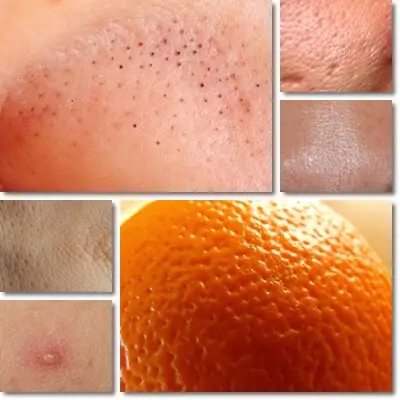Knowing how to best care for your skin type means knowing as much as possible about your skin type. Skin care goes beyond just the right choice of product – skin care is about understanding what is your skin type, why it is the way it is, how it looks by nature, and what to expect in terms of skincare results. No amount of good skin care can change your skin type, only make it look like the best version of itself.
If you have oily skin, then you’ll continue to have oily skin with everything that oily skin entails, from large pores that get clogged easily to a higher sebum production and associated shine, and a predisposition to acne. But what don’t you know about oily skin? Here are 7 things you didn’t know about oily skin.

Fact 1: Oily skin is a normal skin type
Oily skin is not bad skin. While it’s regarded as the worst skin type to have because it makes you oily and shiny, causes makeup to move around and more, it’s actually a normal skin type. There’s oily skin, which is characterized by a higher production of sebum, dry skin, which is skin that feels and looks dry, mixed skin, with oily forehead, nose and chin and dry cheeks, and normal skin which is more balanced.
What is sebum?
Sebum is an oily secretion of glands called sebaceous glands. Sebum is oily, waxy even. Sebum is made of fats such as triglycerides, free fatty acids, wax esters, squalene, keratin and cell metabolites. The function of sebum is to lubricate the skin, covering it in a protective oily coating and preventing bacteria and other potentially pathogenic microorganisms to infiltrate into the skin. Sebum also helps keep skin moist, moisturized and feeling good.
What are sebaceous glands?
Sebaceous glands are glands that secrete the substance called sebum at the surface of the skin via a duct. The skin of the scalp and face has the most sebaceous glands, followed by areas such as the upper back and the shoulder blades in particular, and upper chest area. Sebaceous glands are microscopic, but produce very visible effects, especially in oily skin types.

Fact 2: Oily skin is naturally more textured
Oily skin tends to be more textured. This is because oily skin comes with more visibly open pores, sometimes quite large. Nose pores and cheek pores near the nose tend to be larger than pores on other areas of the face. Open pores also get clogged, and the larger they are, the more visible the blackheads and whiteheads. Excess sebum, which is characteristic of oily skin types, also makes the skin more prone to acne and acne scars which add to the texture. All of this contributes to the uneven, textured surface of oily skin.
Fact 3: Oily skin displaces makeup
Oily skin is known to cause makeup to move on the face. The sebum that is produced underneath the makeup essentially displaces the makeup products, causing makeup to run, crease or move around the face. At one point, sebum breaks through the makeup and leads to an oily shine which is most visible on the forehead, nose and sides of the nose, and chin (the T-zone).
Too much makeup on an oily skin type will look caked and unnatural, and is also more likely to crease. Liquid foundation tends to get absorbed into the skin and cause you to lose coverage. Sweating and warm, humid weather will cause excess sebum to be produced and oily skin to be even oilier, compromising the best of makeup in under 2 hours.
Fact 4: Oily skin can be dehydrated
Did you know oily skin can become chronically dehydrated? Lack of proper hydration causes oily skin to become even oilier. There is a fine balance that needs to be maintained when it comes to oily skin and hydration plays a crucial part in this balance. Without proper hydration, both from within and from the outside, oily skin can become dehydrated.
Not drinking enough water, drinking too much naturally sparkling or mineral water and too little flat water, not washing the skin/face with water or applying moisture to it can result in the skin becoming dehydrated. Dehydration then causes an increase in the production of sebum and makes oily skin become even oilier, and look the part.
Fact 5: You can clean oily skin with just water
Did you know that a few good splashes of warm water on the face in the morning and evening can help cleanse even the oiliest of skins? Water alone is enough to clear excess sebum without affecting the skin barrier, helping the skin adjust its oil production without the use of harsh or expensive skin care products. Of course, the skin needs some training, but you will reap great benefits off this simple and accessible skin care trick. For a deeper cleansing, gentle gel and foam skin care products are the best for oily skin.
Fact 6: Oily skin needs regular exfoliating
You can’t have good looking oily skin without exfoliating regularly. Depending on the extent of oiliness and harshness of products used, exfoliation may occur 1-3 times a week or even daily. If you have a gentle gel or foam-based exfoliating product, you can exfoliate daily, just be gentle about it and keep the process under 2 minutes. If you are using products with micro-beads, which are best avoided because of their negative impact on the environment, or even more natural products such as clay or sugar, keep to 1-3 times a week. If you are using harsher skin care products with various chemicals that offer a peeling-like effect, consider a frequency of once a week tops.
Fact 7: Oily skin fares better with age
Having oily skin is somewhat protective and can even help delay wrinkles or reduce their appearance. Oilier skin is naturally more textured, and even slightly thicker than other skin types in certain areas, and this can help with wrinkle appearance. The sebum secreted in higher amounts in oily skin types also protects skin and contributes to skin elasticity which can delay wrinkles.
At the same time, large facial pores are more likely in oily skin and aged oily skin. As the skin loses elasticity with age, pores can appear larger, but good skincare, even higher-end dermatological treatments such as laser treatment can help with more stubborn large pore issues.
Conclusion
Oily skin can never truly achieve a matte, but dewy, poreless, airbrushed finish, but good skin care and the right choice of products can make it look its best. Of course, it’s true that oily skin is often times more difficult to care for because of its more complex nature, but it does have its benefits. And considering it’s a normal skin type, there’s really nothing intrinsically wrong with oily skin.
